Charles E W Bean, Diaries, AWM38 3DRL 606/253/1 - 1918 - 1939 - Part 15
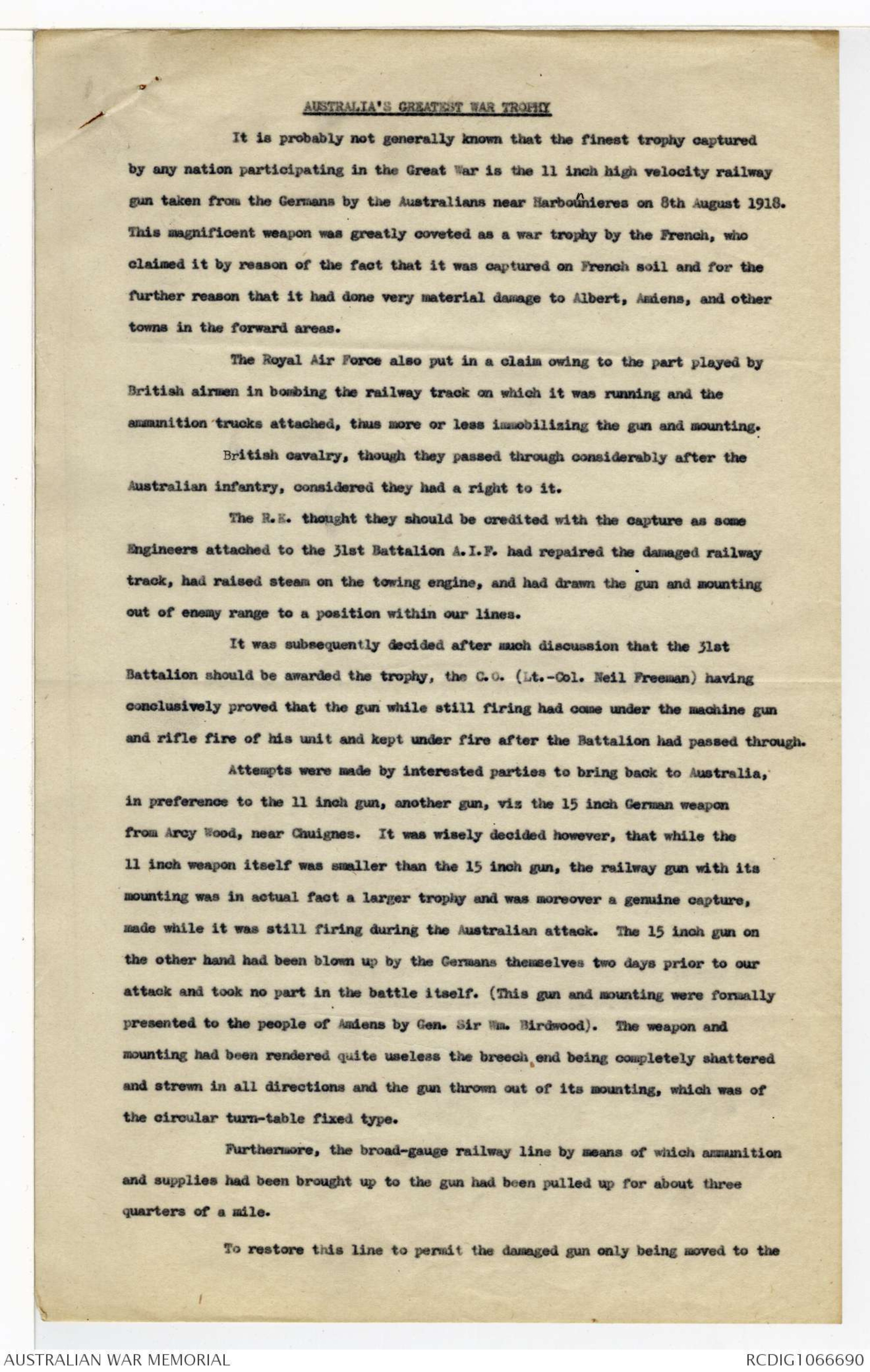
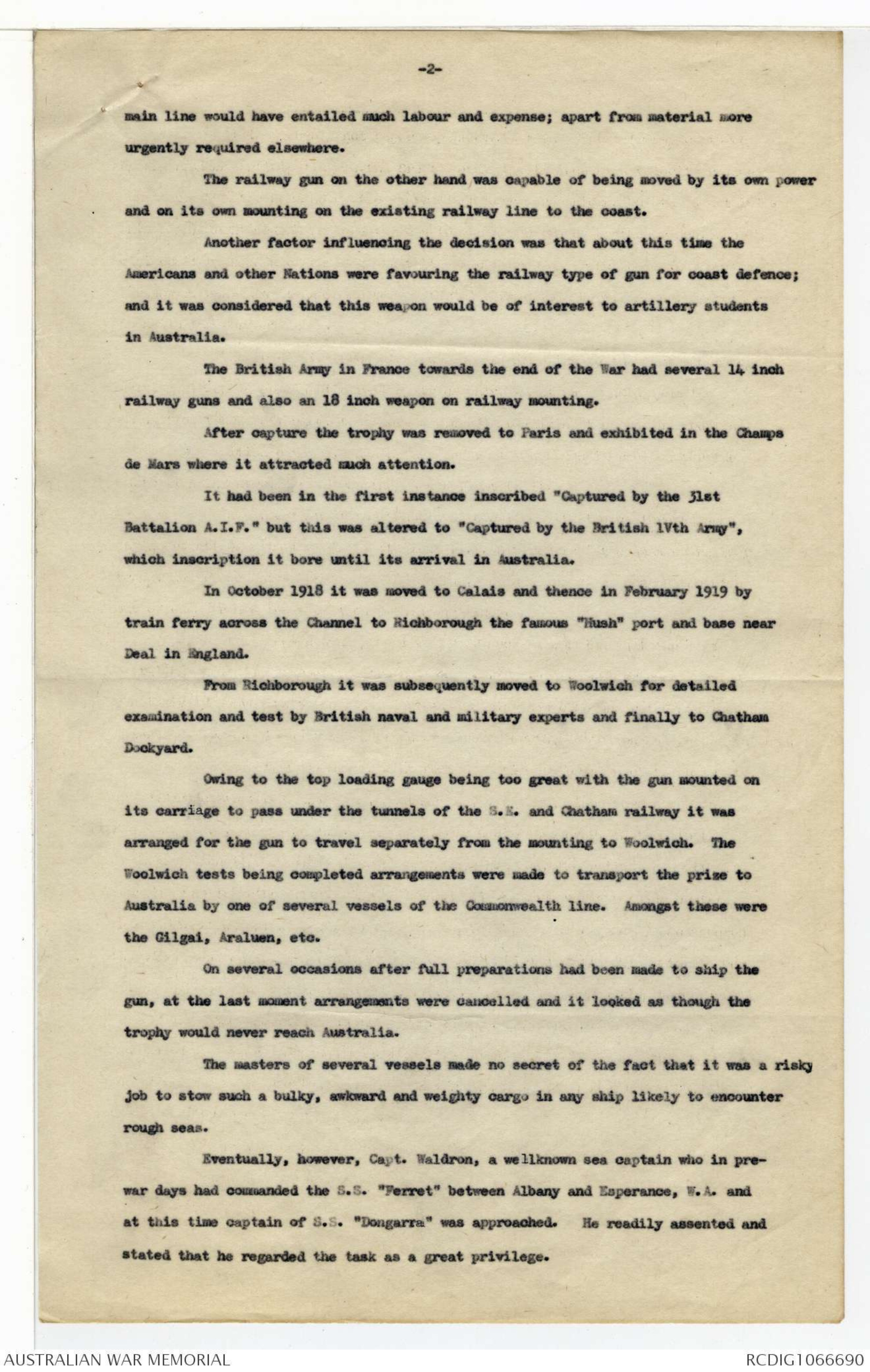
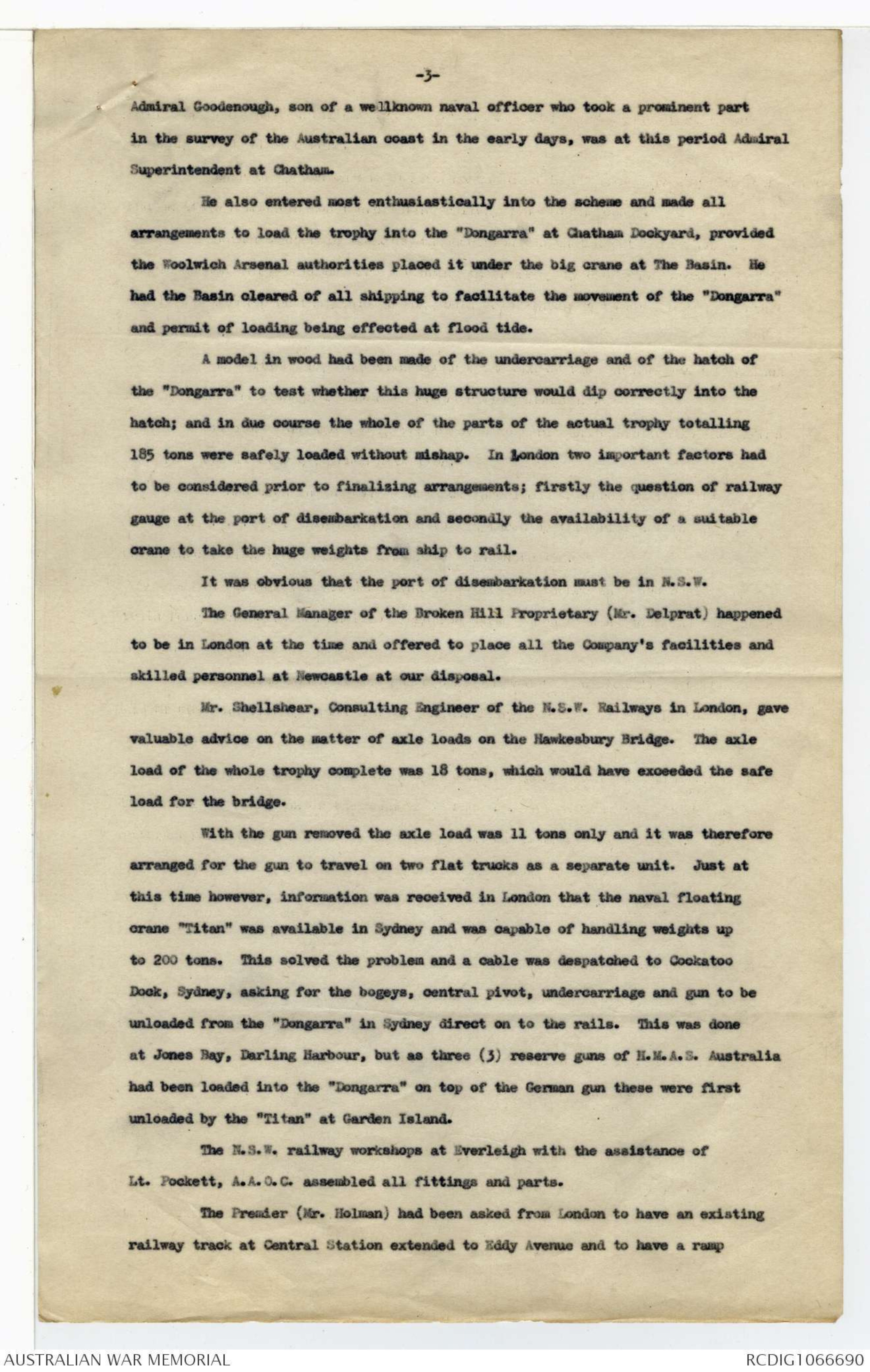
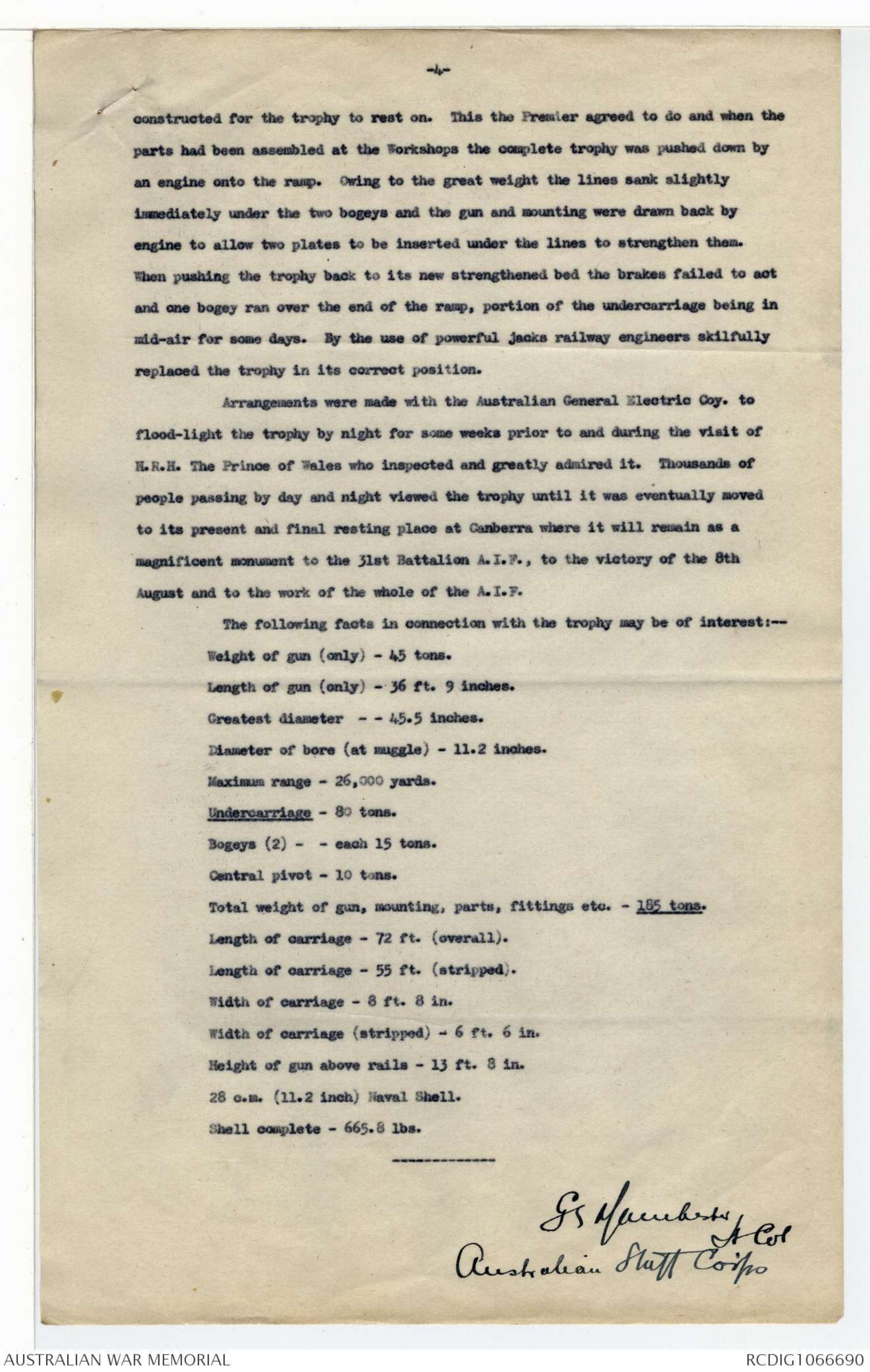

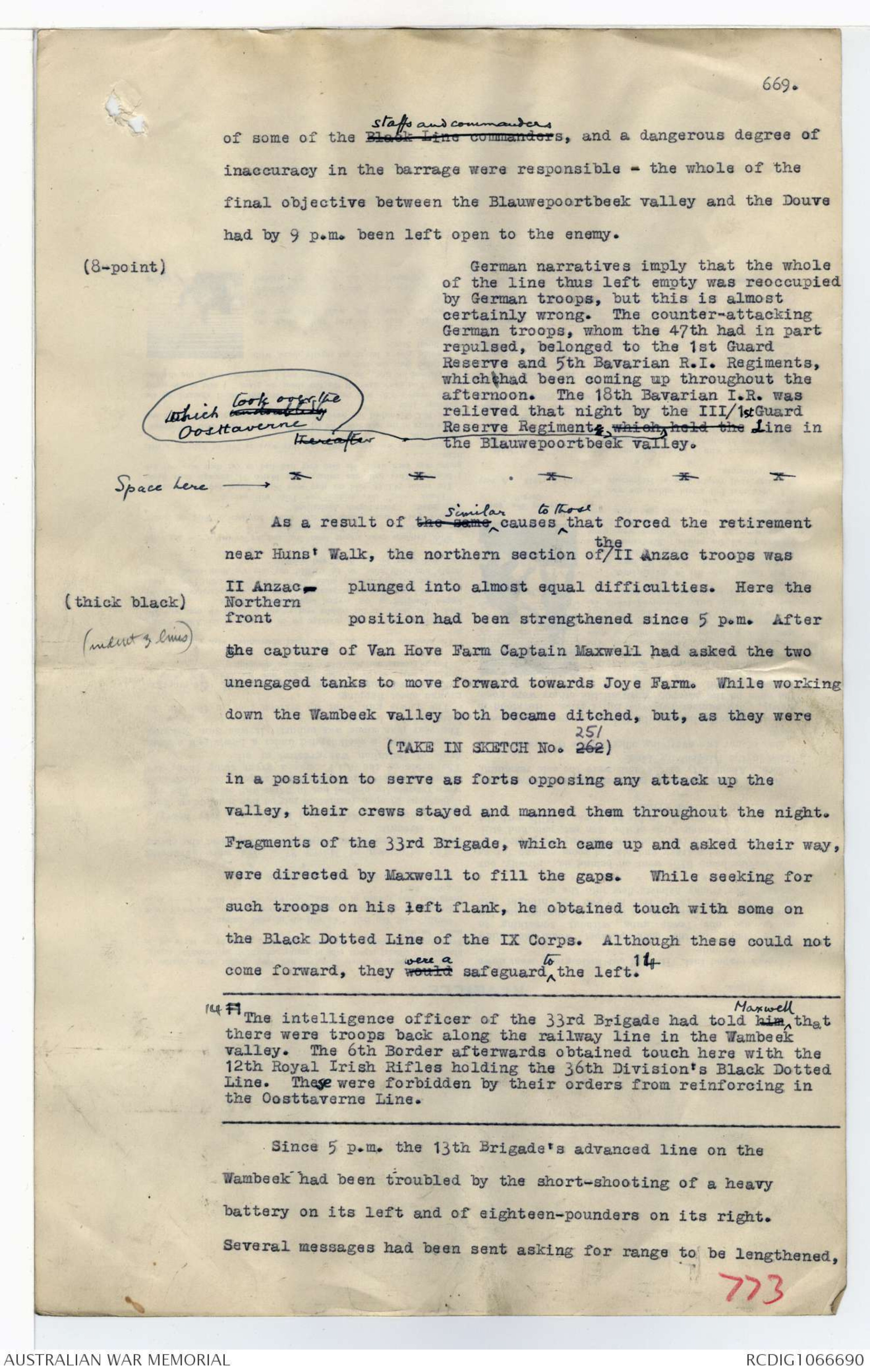
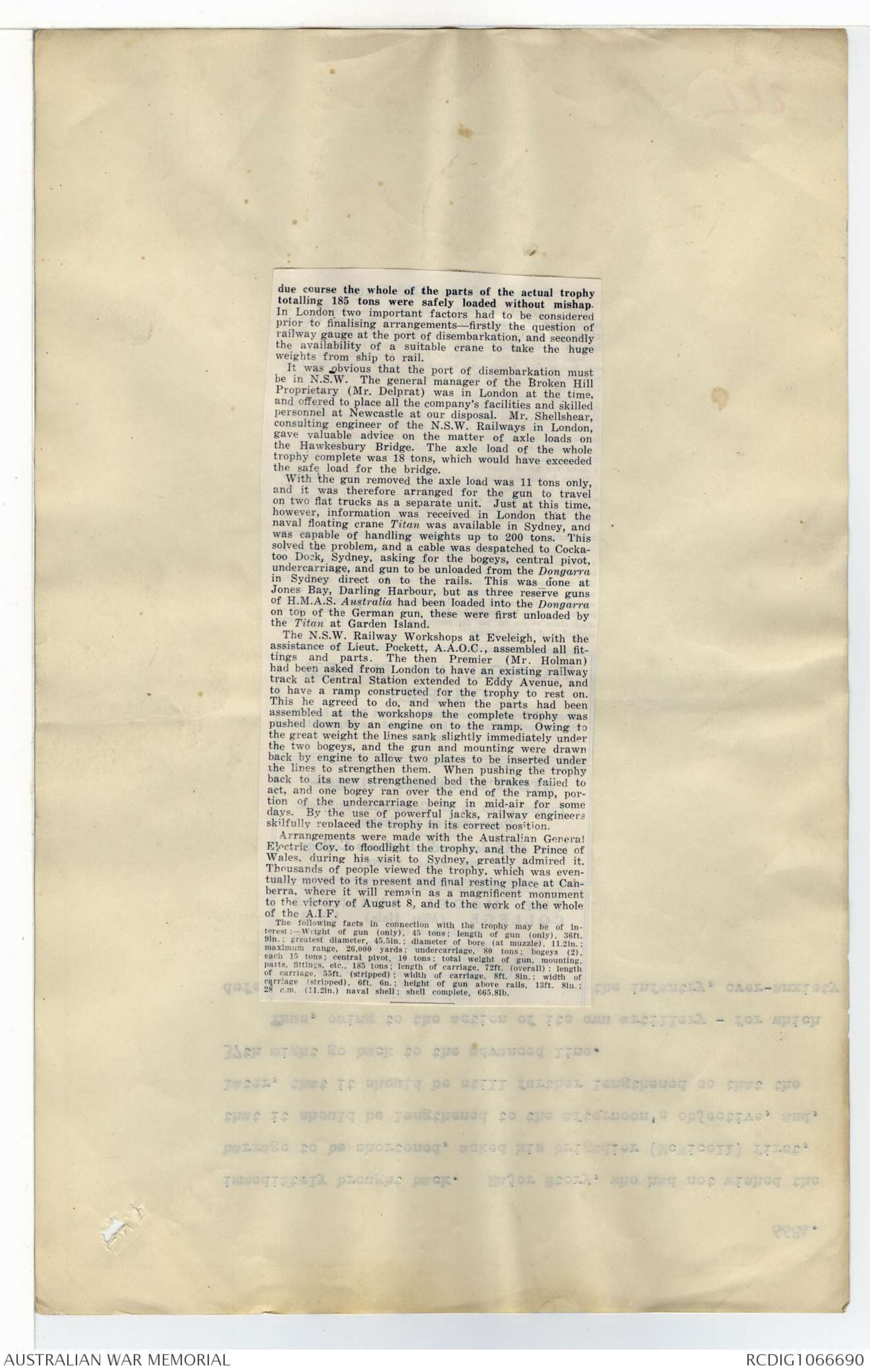

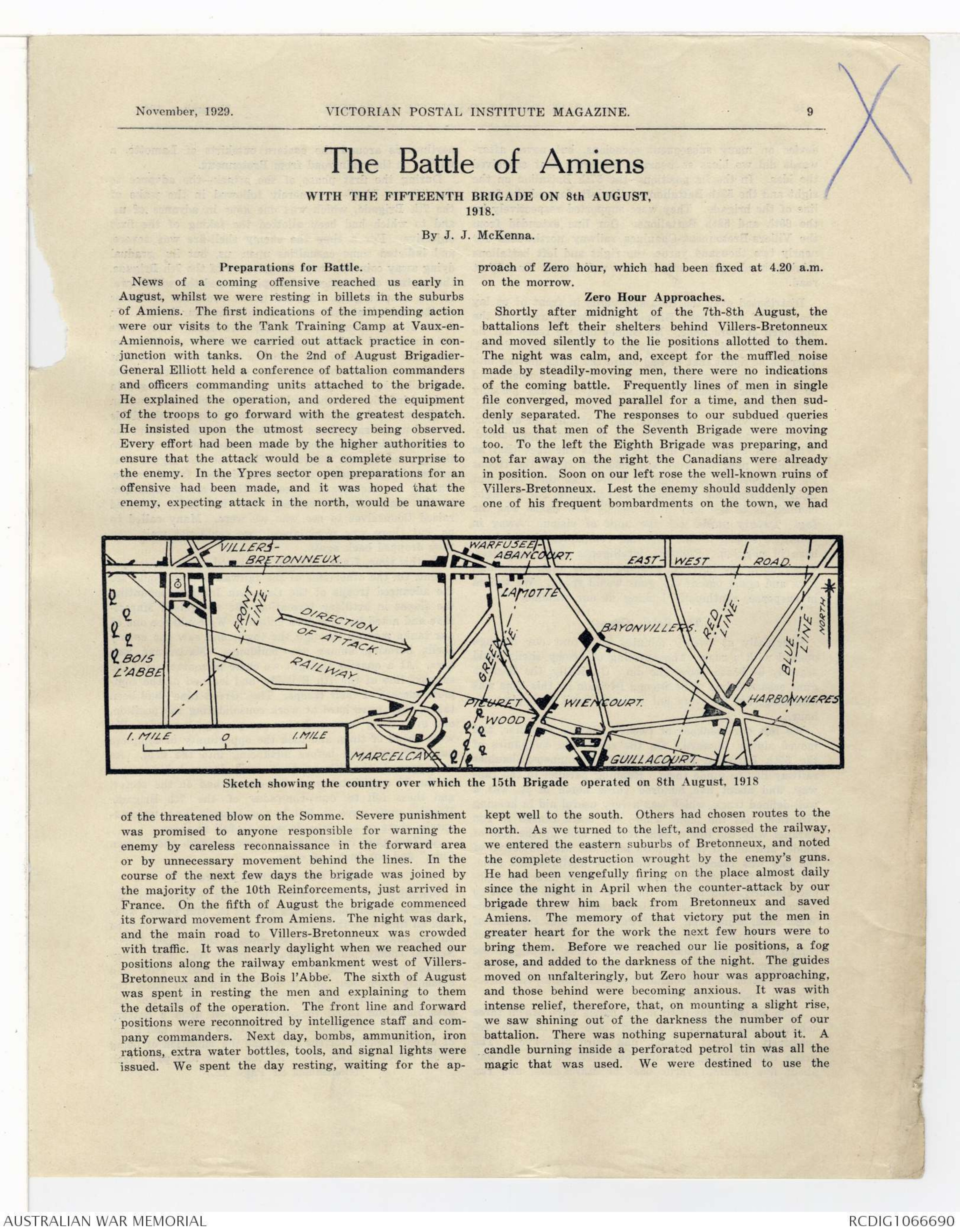
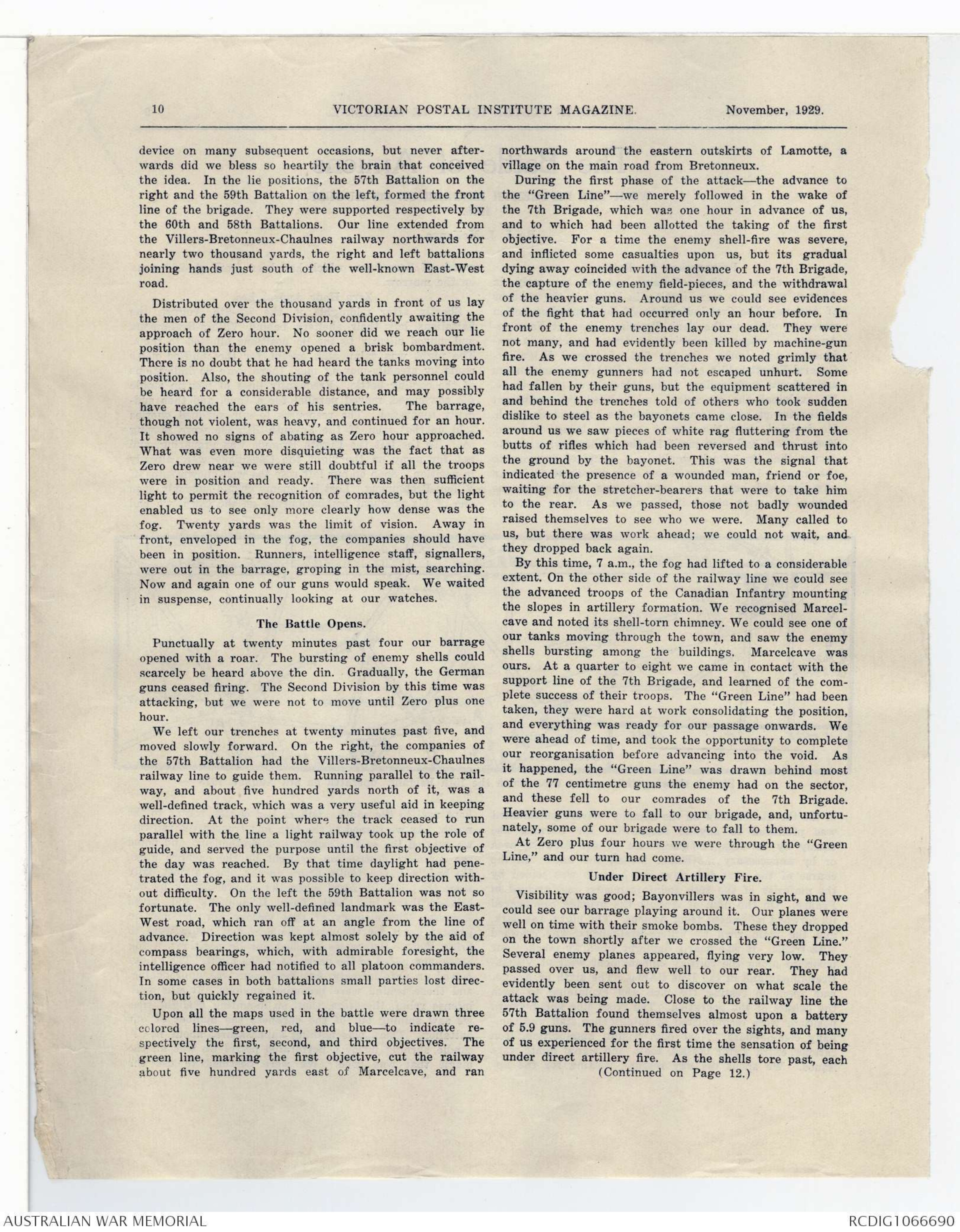
AUSTRALIA'S GREATEST WAR TROPHY
It is probably not generally known that the finest trophy captured
by any nation participating in the Great War is the 11 inch high velocity railway
gun taken from the Germans by the Australians near Harbounnieres on 8th August 1918.
This magnificent weapon was greatly coveted as a war trophy by the French, who
claimed it by reason of the fact that it was captured on French soil, and for the
further reason that it had done very material damage to Albert, Amiens, and other
towns in the forward areas.
The Royal Air Force also put in a claim owing to the part played by
British airmen in bombing the railway track on which it was running and the
ammunition trucks attached, thus more or less immobilizing the gun and mounting.
British cavalry, though they passed through considerably after the
Australian infantry, considered they had a right to it.
The R. E. thought they should be credited with the capture as some
Engineers attached to the 31st Battalion A.I.F. had repaired the damaged railway
track, had raised steam on the towing engine, and had drawn the gun and mounting
out of enemy range to a position within our lines.
It was subsequently decided after much discussion that the 31st
Battalion should be awarded the trophy, the C.O. (Lt.-Col. Neil Freeman) having
conclusively proved that the gun while still firing had come under the machine gun
and rifle fire of his unit and kept under fire after the Battalion had passed through.
Attempts were made by interested parties to bring back to Australia,
in preference to the 11 inch gun, another gun, viz the 15 inch German weapon
from Arcy Wood, near Chuignes. It was wisely decided however, that while the
11 inch weapon itself was smaller than the 15 inch gun, the railway gun with its
mounting was in actual fact a larger trophy and was moreover a genuine capture,
made while it was still firing during the Australian attack. The 15 inch gun on
the other hand had been blown up by the Germans themselves two days prior to our
attack and took no part in the battle itself. (This gun and mounting were formally
presented to the people of Amiens by Gen. Sir Wm. Birdwood). The weapon and
mounting had been rendered quite useless the breech end being completely shattered
and strewn in all directions and the gun thrown out of its mounting, which was of
the circular turn-table fixed type.
Furthermore, the broad-gauge railway line by means of which ammunition
and supplies had been brought up to the gun had been pulled up for about three
quarters of a mile.
To restore this line to permit the damaged gun only being moved to the
-2-
main line would have entailed much labour and expense; apart from material more
urgently required elsewhere.
The railway gun on the other hand was capable of being moved by its own power
and on its own mounting on the existing railway line to the coast.
Another factor influencing the decision was that about this time the
Americans and other Nations were favouring the railway type of gun for coast defence;
and it was considered that this weapon would be of interest to artillery students
in Australia.
The British Army in France towards the end of the War had several 14 inch
railway guns and also an 18 inch weapon on railway mounting.
After capture the trophy was removed to Paris and exhibited in the Champs
de Mars where it attracted much attention.
It had been in the first instance inscribed "Captured by the 31st
Battalion A.I.F." but this was altered to "Captured by the British IVth Army",
which inscription it bore until its arrival in Australia.
In October 1918 it was moved to Calais and thence in February 1919 by
train ferry across the Channel to Richborough the famous "Hush" port and base near
Deal in England.
From Richborough it was subsequently moved to Woolwich for detailed
examination and test by British naval and military experts and finally to Chatham
Dockyard.
Owing to the top loading gauge being too great with the gun mounted on
its carriage to pass under the tunnels of the S.E. and Chatham railway it was
arranged for the gun to travel separately from the mounting to Woolwich. The
Woolwich tests being completed arrangements were made to transport the prize to
Australia by one of several vessels of the Commonwealth line. Amongst these
were the Gilgai, Araluen, etc.
On several occasions after full preparations had been made to ship the
gun, at the last moment arrangements were cancelled and it looked as though the
trophy would never reach Australia.
The masters of several vessels made no secret of the fact that it was a risky
job to stow such a bulky, awkward and weighty cargo in any ship likely to encounter
rough seas.
Eventually, however, Capt. Waldron, a wellknown sea captain who in pre-war
days had commanded the S.S. "Ferret" between Albany and Esperance, W.A. and
at this time captain of S.S. "Dongarra" was approached. He readily assented and
stated that he regarded the task as a great privilege.
-3-
Admiral Goodenough, son of a wellknown naval officer who took a prominent part
in the survey of the Australian coast in the early days, was at this period Admiral
Superintendent at Chatham.
He also entered most enthusiastically into the scheme and made all
arrangements to load the trophy into the "Dongarra" at Chatham Dockyard, provided
the Woolwich Arsenal authorities placed it under the big crane at The Basin. He
had the Basin cleared of all shipping to facilitate the movement of the "Dongarra"
and permit of loading being effected at flood tide.
A model in wood had been made of the undercarriage and of the hatch of
the "Dongarra" to test whether this huge structure would dip correctly into the
hatch; and in due course the whole of the parts of the actual trophy totalling
185 tons were safely loaded without mishap. In London two important factors had
to be considered prior to finalizing arrangements; firstly the question of railway
gauge at the port of disembarkation and secondly the availability of a suitable
crane to take the huge weights from ship to rail.
It was obvious that the port of disembarkation must be in N.S.W.
The General Manager of the Broken Hill Proprietary (Mr. Delprat) happened
to be in London at the time and offered to place all the Company's facilities and
skilled personnel at Newcastle at our disposal.
Mr. Shellshear, Consulting Engineer of the N.S.W. Railways in London, gave
valuable advice on the matter of axle loads on the Hawkesbury Bridge. The axle
load of the whole trophy complete was 18 tons, which would have exceeded the safe
load for the bridge.
With the gun removed the axle load was 11 tons only and it was therefore
arranged for the gun to travel on two flat trucks as a separate unit. Just at
this time however, information was received in London that the naval floating
crane "Titan" was available in Sydney and was capable of handling weights up
to 200 tons. This solved the problem and a cable was despatched to Cockatoo
Dock, Sydney, asking for the bogeys, central pivot, undercarriage and gun to be
unloaded from the "Dongarra" in Sydney direct on to the rails. This was done
at Jones Bay, Darling Harbour, but as three (3) reserve guns of H.M.A.S. Australia
had been loaded into the "Dongarra" on top of the German gun these were first
unloaded by the "Titan" at Garden Island.
The N.S.W. railway workshops at Everleigh with the assistance of
Lt. Pockett, A.A.O.C. assembled all fittings and parts.
The Premier (Mr. Holman) had been asked from London to have an existing
railway track at Central Station extended to Eddy Avenue and to have a ramp
-4-
constructed for the trophy to rest on. This the Premier agreed to do and when the
parts had been assembled at the Workshops the complete trophy was pushed down by
an engine onto the ramp. Owing to the great weight the lines sank slightly
immediately under the two bogeys and the gun and mounting were drawn back by
engine to allow two plates to be inserted under the lines to strengthen them.
When pushing the trophy back to its new strengthened bed the brakes failed to act
and one bogey ran over the end of the ramp, portion of the undercarriage being in
mid-air for some days. By the use of powerful jacks railway engineers skilfully
replaced the trophy in its correct position.
Arrangements were made with the Australian General Electric Coy. to
flood-light the trophy by night for some weeks prior to and during the visit of
H.R.H. The Prince of Wales who inspected and greatly admired it. Thousands of
people passing by day and night viewed the trophy until it was eventually moved
to its present and final resting place at Canberra where it will remain as a
magnificent monument to the 31st Battalion A.I.F., to the victory of the 8th
August and to the work of the whole of the A.I.F.
The following facts in connection with the trophy may be of interest:--
Weight of gun (only) - 45 tons.
Length of gun (only) - 36 ft. 9 inches.
Greatest diameter - - 45.5 inches.
Diameter of bore (at muggle) - 11.2 inches.
Maximum range - 26,000 yards.
Undercarriage - 80 tons.
Bogeys (2) - - each 15 tons.
Central pivot - 10 tons.
Total weight of gun, mounting, parts, fittings etc. - 185 tons.
Length of carriage - 72 ft. (overall).
Length of carriage - 55 ft. (stripped).
Width of carriage - 8 ft. 8 in.
Width of carriage (stripped) - 6 ft. 6 in.
Height of gun above rails - 13 ft. 8 in.
28 c.m. (11.2 inch) Naval Shell.
Shell complete - 665.8 lbs.
GE Manchester
Lt Col
Australian Staff Corps
REVEILLE
July 1, 1934.
GREATEST WAR TROPHY
31st Battalion's Capture in France
Diagram, Broadsheet, or printed page - see original document.
How the monster 11-inch railway gun, which was captured by the 31st
Bn., A.I.F., at Harbonnieres on the opening day of the August, 1918,
offensive, was transported to Australia - how all difficulties, some political,
were overcome, including the designs of the French to retain it as a trophy
of war for their people - is told in this article by Lieut.-Col. G. E.
Manchester, of the Australian Staff Corps, who had charge of all the
arrangements.
THE finest trophy captured by any nation participating
in the Great War is the 11-inch high velocity railway
gun taken from the Germans by the Australians
near Harbonnieres on August 8, 1918. This magnificent
weapon was greatly coveted as a war trophy by
the French, who claimed it by reason of the fact that it
was captured on French soil, and for the further reason
that it had done very material damage to Albert, Amiens,
and other towns in the forward areas.
The Royal Air Force also put in a claim, owing to
the part played by British airmen in bombing the railway
track on which it was operated and the ammunition
trucks attached, thus more or less immobilising the
gun and mounting. British cavalry, though they passed
through considerably after the Australian infantry, considered
they had a right to it. The R.E. thought they
should be credited with the capture, as some engineers
attached to the 31st Bn., A.I.F., had repaired the damaged
railway track, had raised steam on the towing
engine, and had drawn the gun and mounting out of
enemy range to a position within our lines.
After much discussion the 31st Bn. was awarded the
trophy, the C.O. (Lieut.-Colonel Neil Freeman) having
conclusively proved that the gun, while still firing, had
come under machine-gun and rifle fire of his unit and
been kept under fire after the battalion had passed through
Attempts were made by interested parties to bring back
to Australia, in preference to the 11-inch gun, another
gun, viz., the 15-inch German weapon from Arcy Wood,
near Chuignes. It was wisely decided, however, that
while the 11-inch weapon itself was smaller than the
15-inch gun, the railway gun, with its mounting, was
in actual fact a larger trophy, and was moreover a
genuine capture, made while it was still firing during
the Australian attack. The 15-inch gun, on the other
hand, had been blown up by the Germans themselves two
days prior to our attack, and in the end this gun and
mounting were formally presented to the people of Amiens
by General Sir Wm. Birdwood.
A factor influencing the decision to have the railway
gun captured at Harbonnieres sent to Australia was that
about this time nations, including America, were favouring
the railway type of gun for coast defence, and
it was considered that this weapon would be of interest
to artillery students in Australia. The British Army in
France towards the end of the war had several 14-inch
railway guns, and also an 18-inch weapon on railway
mounting.
After capture the trophy was removed to Paris and
exhibited in the Champs de Mars, where it attracted
much attention. It had been in the first instance inscribed,
"Captured by the 31st Bn., A.I.F.," but this was
altered to, "Captured by the British IV. Army," which
inscription it bore until its arrival in Australia. In
October, 1918, it was moved to Calais, and thence, in
February, 1919, by train ferry across the Channel to
Richborough, the famous "Hush" port and base near
Deal in England. From Richborough it was subsequently
moved to Woolwich for detailed examination and test by
British naval and military experts, and finally to Chatham
Dockyard.
Owing to the top loading gauge being too great with
the gun mounted on its carriage to pass under the tunnels
of the S.E. and Chatham railway it was arranged
for the gun to travel separately from the mounting to
Woolwich. The Woolwich tests being completed, arrangements
were made to transport the prize to Australia. On
several occasions, after full preparations had been made
to ship the gun, at the last moment arrangements were
cancelled, and it looked as though the trophy would never
reach Australia. The masters of the Commonwealth Line
vessels made no secret of the fact that it was a risky job
to stow such a bulky, awkward and weighty cargo in
any ship likely to encounter rough seas. Eventually,
however, Capt. Waldron, a well-known sea captain, who
in pre-war days had commanded the s.s. Ferret between
Albany and Esperance, W.A., and at this time was captain
of s.s. Dongarra, was approached. He readily
assented, stating that he regarded the task as a great
privilege.
Admiral Goodenough, son of a well-known naval
officer, who took a prominent part in the survey of the
Australian coast in the early days, was at this period
Admiral Superintendent at Chatham. He also entered
enthusiastically into the scheme, and made all arrangements
to load the trophy into the Dongarra at Chatham
Dockyard, and had the Basin cleared of all shipping to
facilitate the movement of the Dongarra and permit of
loading being effected at flood tide.
A model in wood had been made of the undercarriage
and of the hatch of the "Dongarra" to test whether this
huge structure would dip correctly into the hatch; and in
669.
of some of the Black Line commanders staffs and commanders, and a dangerous degree of
inaccuracy in the barrage were responsible - the whole of the
final objective between the Blauwepoortbeek valley and the Douve
had by 9 p.m. been left open to the enemy.
(8-point)
German narratives imply that the whole
of the line thus left empty was reoccupied
by German troops, but this is almost
certainly wrong. The counter-attacking
German troops, whom the 47th had in part
repulsed, belonged to the 1st Guard
Reserve and 5th Bavarian R.I. Regiments,
which e had been coming up throughout the
afternoon. The 18th Bavarian I.R. was
relieved that night by the III/1st Guard
Reserve Regiments, which ^ which undoubtablly took over the Oosttaverne held the Line inthereafter the Blauwepoortbeek valley.
Space here → x x x x
As a result of the same ^ similar causes ^ to those that forced the retirement
near Huns' Walk, the northern section of/the II Anzac troops was
II Anzac - plunged into almost equal difficulties. Here the
thick black) Northern
front position had been strengthened since 5 p.m. After
[*indent 3 lines*]
the capture of Van Hove Farm Captain Maxwell had asked the two
unengaged tanks to move forward towards Joye Farm. While working
down the Wambeek valley both became ditched, but, as they were
(TAKE IN SKETCH No. 262 251)
in a position to serve as forts opposing any attack up the
valley, their crews stayed and manned them throughout the night.
Fragments of the 33rd Brigade, which came up and asked their way,
were directed by Maxwell to fill the gaps. While seeking for
such troops on his left flank, he obtained touch with some on
the Black Dotted Line of the IX Corps. Although these could not
come forward, they would ^ were a safeguard ^ to the left. 14
--------------------------------------------------------------------------------------------------
14 F1 The intelligence officer of the 33rd Brigade had told him ^ Maxwell that
there were troops back along the railway line in the Wambeek
valley. The 6th Border afterwards obtained touch here with the
12th Royal Irish Rifles holding the 36th Division's Black Dotted
Line. These were forbidden by their orders from reinforcing in
the Oosttaverne Line.
----------------------------------------------------------------------------------------------------
Since 5 p.m. the 13th Brigade's advanced line on the
Wambeek had been troubled by the short-shooting of a heavy
battery on its left and of eighteen-pounders on its right.
Several messages had been sent asking for range to be lengthened,
773
due course the whole of the parts of the actual trophy
totalling 185 tons were safely loaded without mishap
In London two important factors had to be considered
prior to finalising arrangements - firstly the question of
railway gauge at the port of disembarkation, and secondly
the availability of a suitable crane to take the huge
weights from ship to rail.
It was obvious that the port of disembarkation must
be in N.S.W. The general manager of the Broken Hill
Proprietary (Mr. Delprat) was in London at the time,
and offered to place all the company's facilities and skilled
personnel at Newcastle at our disposal. Mr. Shellshear,
consulting engineer of the N.S.W. Railways in London,
gave valuable advice on the matter of axle loads on
the Hawkesbury Bridge. The axle load of the whole
trophy complete was 18 tons, which would have exceeded
the safe load for the bridge.
With the gun removed the axle load was 11 tons only,
and it was therefore arranged for the gun to travel
on two flat trucks as a separate unit. Just at this time,
however, information was received in London that the
naval floating crane Titan was available in Sydney, and
was capable of handling weights up to 200 tons. This
solved the problem, and a cable was despatched to Cockatoo
Dock, Sydney, asking for the bogeys, central pivot,
undercarriage, and gun to be unloaded from the Dongarra
in Sydney direct on to the rails. This was done at
Jones Bay, Darling Harbour, but as three reserve guns
of H.M.A.S. Australia had been loaded into the Dongarra
on top of the German gun, these were first unloaded by
the Titan at Garden Island.
The N.S.W. Railway Workshops at Eveleigh, with the
assistance of LIeut. Pockett, A.A.O.C., assembled all fittings
and parts. The then Premier (Mr. Holman)
had been asked from London to have an existing railway
track at Central Station extended to Eddy Avenue, and
to have a ramp constructed for the trophy to rest on.
This he agreed to do, and when the parts had been
assembled at the workshops the complete trophy was
pushed down by a engine on to the ramp. Owing to
the great weight the lines sank slightly immediately under
the two bogeys, and the gun and mounting were drawn
back by the engine to allow two plates to be inserted under
the lines to strengthen them. When pushing the trophy
back to its new strengthened bed the brakes failed to
act, and one bogey ran over the end of the ramp, portion
of the undercarriage being in mid-air for some
days. By the use of powerful jacks, railway engineers
skilfully replaced the trophy in its correct position.
Arrangements were made with the Australian General
Electric Coy. to floodlight the trophy, and the Prince of
Wales, during his visit to Sydney, greatly admired it.
Thousands of people viewed the trophy, which was eventually
moved to its present and final resting place at Canberra,
where it will remain as a magnificent monument
to the victory of August 8, and to the work of the whole
of the A.I.F.
The following facts in connection with the trophy may be of interest :-
Weight of gun (only), 45 tons; length of gun (only), 36ft.
9in.; greatest diameter, 45.5in.; diameter of bore (at muzzle), 11.2in. ;
maximum range, 26,000 yards; undercarriage, 80 tons; bogeys (2),
each 15 tons; central pivot, 10 tons; total weight of gun, mounting,
parts, fittings, etc., 185 tons; length of carriage, 72ft. (overall); length
of carriage, 55ft. (stripped); width of carriage, 8ft. 8in.; width of
carriage (stripped), 6ft. 6n.; height of gun above rails. 13ft. 8in.;
28 c.m. (11.2in.) naval shell; shell complete, 665.8lb.
668A.
immediately brought back. Major Story, who had not wished the
barrage to be shortened, asked his brigadier (McNicoll) first,
that it should be lengthened to the afternoon's objective, and,
later, that it should be still further lengthened so that the
37th might go back to the advanced line.
Thus, owing to the action of its own artillery - for which
defects in the maps, over-eagerness of the infantry, over-anxiety
772
November, 1929. VICTORIAN POSTAL INSTITUTE MAGAZINE. 9
------------------------------------------------------------------------------------------ X
The Battle of Amiens
WITH THE FIFTEENTH BRIGADE ON 8th AUGUST,
1918,
By J. J. McKenna.
Preparations for Battle.
News of a coming offensive reached us early in
August, whilst we were resting in billets in the suburbs
of Amiens. The first indication of the impending action
were our visits to the Tank Training Camp at Vaux-en-Amiennois,
where we carried out attack practice in conjunction
with tanks. On the 2nd of August Brigadier-General
Elliott held a conference of battalion commanders
and officers commanding units attached to the brigade.
He explained the operation, and ordered the equipment
of the troops to go forward with the greatest despatch.
He insisted upon the utmost secrecy being observed.
Every effort had been made by the higher authorities to
ensure that the attack would be a complete surprise to
the enemy. In the Ypes sector open preparations for an
offensive had been made, and it was hoped that the
enemy, expecting attack in the north, would be unaware
Diagram, Broadsheet, or printed page - see original document.
Sketch showing the country over which the 15th Brigade
operated on 8th August, 1918
of the threatened blow on the Somme. Severe punishment
was promised to anyone responsible for warning the
enemy by careless reconnaissance in the forward area
or by unnecessary movement behind the lines. In the
course of the next few days the brigade was joined by
the majority of the 10th Reinforcements, just arrived in
France. On the fifth of August the brigade commenced
its forward movement from Amiens. The night was dark,
and the main road to Villers-Bretonneux was crowded
with traffic. It was nearly daylight when we reached our
positions along the railway embankment west of
Villers-Bretonneux and in the Bois l'Ábbe. The sixth of August
was spent in resting the men and explaining to them
the details of the operation. The front line and forward
positions were reconnoitred by intelligence staff and company
commanders. Next day, bombs, ammunition, iron
rations, extra water bottles, tools, and signal lights were
issued. We spent the day resting, waiting for the approach
of Zero hour, which had been fixed at 4.20 a.m.
on the morrow
Zero Hour Approaches.
Shortly after midnight of the 7th-8th August, the
battalions left their shelters behind Villers-Bretonneux
and moved silently to the lie positions allotted to them.
The night was calm, and, except for the muffled noise
made by steadily-moving men, there were no indications
of the coming battle. Frequently lines of men in single
file converged, moved parallel for a time, and then suddenly
separated. The responses to our subdued queries
told us that men of the Seventh Brigade were moving
too. To the left the Eighth Brigade was preparing, and
not far away on the right the Canadians were already
in position. Soon on our left rose the well-known ruins of
Villers-Bretonneux. Lest the enemy should suddenly open
one of his frequent bombardments on the town, we had
kept well to the south. Others had chosen routes to the
north. As we turned to the left, and crossed the railway,
we entered the eastern suburbs of Bretonneux, and noted
the complete destruction wrought by the enemy's guns.
He had been vengefully firing on the place almost daily
since the night in April when the counter-attack by our
brigade threw him back from Brettoneux and saved
Amiens. The memory of that victory put the men in
greater heart for the work the next few hours were to
bring them. Before we reached our lie positions, a fog
arose, and added to the darkness of the night. The guides
moved on unfalteringly, but Zero hour was approaching,
and those behind were becoming anxious. It was with
intense relief, therefore, that, on mounting a slight rise,
we saw shining out of the darkness the number of our
battalion. There was nothing supernatural about it. A
candle burning inside a perforated petrol tin was all the
magic that was used. We were destined to use the
10 VICTORIAN POSTAL INSTITUTE MAGAZINE. November, 1929.
------------------------------------------------------------------------------------------
device on many subsequent occasions, but never afterwards
did we bless so heartily the brain that conceived
the idea. In the lie positions, the 57th Battalion on the
right and the 59th Battalion on the left, formed the front
line of the brigade. They were supported respectively by
the 60th and 58th Battalions. Our line extended from
the Villers-Bretonneux-Chaulnes railway northwards for
nearly two thousand yards, the right and left battalions
joining hands just south of the well-known East-West
road.
Distributed over the thousand yards in front of us lay
the men of the Second Division, confidently awaiting the
approach of Zero hour. No sooner did we reach our lie
position than the enemy opened a brisk bombardment.
There is no doubt that he had heard the ranks moving into
position. Also, the shouting of the tank personnel could
be heard for a considerable distance, and may possibly
have reached the ears of his sentries. The barrage,
though not violent, was heavy, and continued for an hour.
It showed no signs of abating as Zero hour approached.
What was even more disquieting was the fact that as
Zero drew near we were still doubtful if all the troops
were in position and ready. There was then sufficient
light to permit the recognition of comrades, but the light
enabled us to see only more clearly how dense was the
fog. Twenty yards was the limit of vision. Away in
front, enveloped in the fog, the companies should have
been in position. Runners, intelligence staff, signallers,
were out in the barrage, groping in the mist, searching.
Now and again one of our guns would speak. We waited
in suspense, continually looking at our watches.
The Battle Opens.
Punctually at twenty minutes past four our barrage
opened with a roar. The bursting of enemy shells could
scarcely be heard above the din. Gradually, the German
guns ceased firing. The Second Division by this time was
attacking, but we were not to move until Zero plus
one hour.
We left our trenches at twenty minutes past five, and
moved slowly forward. On the right, the companies of
the 57th Battalion had the Villers-Bretonneux-Chaulnes
railway line to guide them. Running parallel to the railway,
and about five hundred yards north of it, was a
well-defined track, which was a very useful aid in keeping
direction. At the point where the track ceased to run
parallel with the line a light railway took up the role of
guide, and served the purpose until the first objective of
the day was reached. By that time the daylight had penetrated
the fog, and it was possible to keep the direction without
difficulty. On the left the 59th Battalion was not so
fortunate. The only well-defined landmark was the East-
West road, which ran off at angle from the line of
advance. Direction was kept almost solely by the aid of
compass bearings, which, with admirable foresight, the
intelligence officer had notified to all platoon commanders.
In some cases in both battalions small parties lost direction,
but quickly regained it.
Upon all the maps used in the battle were drawn three
colored lines - green, red, and blue - to indicate respectively
the first, second, and third objectives. The
green line, marking the first objective cut the railway
about five hundred yards east of Marcelcave, and ran
northwards around the eastern outskirts of Lamotte, a
village on the main road from Bretonneux.
During the first phase of the attack—the advance to
the "Green Line"—we merely followed in the wake of
the 7th Brigade, which was one hour in advance of us,
and to which had been allotted the taking of the first
objective. For a time the enemy shell-fire was severe,
and inflicted some casualties upon us, but its gradual
dying away coincided with the advance of the 7th Brigade,
the capture of the enemy field-pieces, and the withdrawal
of the heavier guns. Around us we could see evidences
of the fight that had occurred only an hour before. In
front of the enemy trenches lay our dead. They were
not many, and had evidently been killed by machine-gun
fire. As we crossed the trenches we noted grimly that
all the enemy gunners had not escaped unhurt. Some
had fallen by their guns, but the equipment scattered in
and behind the trenches told of others who took sudden
dislike to steel as the bayonets came close. In the fields
around us we saw piecdes of white flag fluttering from the
butts of rifles which had been reversed and thrust into
the ground by the bayonet. This was the signal that
indicated the presence of a wounded man, friend or foe,
waiting for the stretcher-bearers that were to take him
to the rear. As we passed, those not badly wounded
raised themselves to see who we were. Many called to
us, but there was work ahead; we could not wait, and
they dropped back again.
By this time, 7 a.m., the fog had lifted to a considerable
extent. On the other side of the railway line we could see
the advanced troops of the Canadian Infantry mounting
the slopes in artillery formation. We recognised Marcelcave
and noted its shell-torn chimney. We could see one of
our tanks moving through the town, and saw the enemy
shells bursting among the buildings. Marcelcave was
ours. At a quarter to eight we came in contact with the
support line of the 7th Brigade, and learned of the complete
success of their troops. The "Green Line" had been
taken, they were hard at work consolidating the position,
and everything was ready for our passage onwards. We
were ahead of time, and took the opportunity to complete
our reorganisation before advancing into the void. As
it happened, the "Green Line" was drawn behind most
of the 77 centimetre guns the enemy had on the sector,
and these fell to our comrades of the 7th Brigade.
Heavier guns were to fall to our brigade, and, unfortunately,
some of our brigade were to fall to them.
At Zero plus four hours we were through the "Green Line",
and our turn had come.
Under Direct Artillery Fire.
Visibility was good; Bayonvillers was in sight, and we
could see our barrage playing around it. Our planes were
well on time with their smoke bombs. These they dropped
on the town shortly after we crossed the "Green Line".
Several enemy planes appeared, flying very low. They
passed over us, and flew well to our rear. They had
evidently been sent out to discover on what scale the
attack was being made. Close to the railway line the
57th Battalion found themselves almost upon a battery
of 5.9 guns. The gunners fired over the sights, and many
of us experienced for the first time the sensation of being
under direct artillery fire. As the shells tore past, each
(Continued on Page 12.)
 Sam scott
Sam scottThis transcription item is now locked to you for editing. To release the lock either Save your changes or Cancel.
This lock will be automatically released after 60 minutes of inactivity.